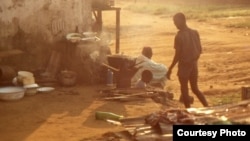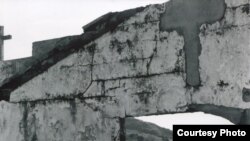Since 1961, hundreds of thousands of young Americans have been sent around the world as Peace Corps volunteers: teachers, community organizers… and friends. The program was the brainchild of President John F. Kennedy, but the youthful enthusiasm of the volunteers really was what brought this idea to life.
Those volunteers come back from the experience with a wealth of memories and photos. More than two dozen of those images are now on display at Round Hill Arts Center, a non-profit art organization in Virginia.
"Bringing The World Home" showcases photographs submitted by Peace Corps volunteers who served in Africa and Latin America from 1971 to 1991.
Jill Evans-Kavaldjian, spokeswoman for the Art Center, said some of the volunteers attended the show's opening and shared their stories with the public, especially youngsters, who had a lot of questions for the Peace Corps veterans.
“For example, how they got their water? How they lived from day-to-day? And the pictures are part of the answer," she said.
Girls in a window
The poster the Round Hill Arts Center printed to publicize the show features a photograph of two little girls in a window. It was taken in 1991 by Lisa Zimmer-Chu, who organized an environmental education program in Panama, and has remained in public service after her Peace Corps experience.
“The children were the first ones who kind of came over first with a great deal of curiosity about us,” she said. “They were really the ones who introduced us to the community in a greater way. These girls were at our house every day. They became family to us.” The girls, Laurena and Leisi, were five and three years old at the time.
Another photo shows Zimmer-Chu holding hands with one of the girls at the ruins of an American church.
“My husband had taken the picture from inside of the church,” she recalled. “That church had not been built by the hands of the people in the community. And the basic tenant of development work is a phrase that goes; ‘if you give a person a fish, they eat for a day. If you teach them to fish, they eat for lifetime.' This church hadn’t been built by the people, not given to them. It was allowed to go to ruin.”
Time in Tranquilla
Meredith Cornett, who also served in Panama in 1991, submitted one picture for the exhibit.
“It’s a very animated shot of the four children who were most essential to my life,” she explained. "I saw them every day, several times a day. They were immigrants to Panama from Colombia. Their family was the most welcoming to me, especially early on. They brought me fish. They sent me meals.
"They really embraced me in a way that I think the rest of the community had trouble doing," Cornett continued. "And I think it was really because of their sort of outsider and marginalized status. They sort of realized I was in the same position so they went out of their way to be kind to me.”
Cornett, who recently published her memoir, Heart of Palms: My Peace Corps Years in Tranquilla, worked in environmental education in the Panamanian town of Tranquilla, which was in the middle of a national park.
“We had 3,000 Panamanians living within the borders of a national park. So [we were] trying to figure out how to continue their farming lifestyle in what had just recently became a protected area,” she said.
Cornett, who is now a scientist with the Nature Conservancy in Minnesota, said her experience in Panama had an enormous impact on her.
“To some, people who are living in that park are viewed as a threat to the natural resources, the forest. I felt - and still feel having gone back and seen all of the amazing restoration work they have been doing - that much more than being a threat, people can also be part of an important restoration or healing process for the natural areas,” she said.
Teaching, Learning in Liberia
George Bergeman and his wife Clarissa taught college and high school students and elementary children in Buchanan, Liberia in 1972.
They submitted six photos of daily life in the country: images of women doing their daily chores, selling fish in the market, baking bread, picking out tiny rocks from rice.
“That is one of the things that you do before you cook rice," George Bergeman explained. "She [one of the women featured in the images] was quite elegant and had moved to Buchanan from Monrovia 30 years, 40 years before we arrived. It was fun visit with her. She talked about her life. She came down in a boat. She brought down a piano with her. The piano fell unfortunately in the ocean. So she regretted it ever since.”
Bergeman’s other images reflect community and traditions and rituals, like a "dancing devil."
“There were two kinds of devil in Liberia. Those that were more commercial that would dance in occasions, and others which were sort of religious. Those wouldn’t be allowed to look upon them. But this was dancing in the occasion of the chief’s birthday," he said. "If you see the picture you would see someone who is dancing in parallel to this dancing devil and then two musicians are behind him playing large box instrument. It’s pretty fantastic music.”
Bergeman says he and his wife believe they gained a lot from their Peace Corps experience in Liberia.
“The longer we were there in Liberia the more we understood things that were in common from people to people and things that were different,” he said. “Today especially, I think Peace Corps volunteers can have an impact and make a difference in terms of the work they do but also just the people to people aspect.”
That’s what the “Bringing the World Home” exhibit highlights and celebrates.












